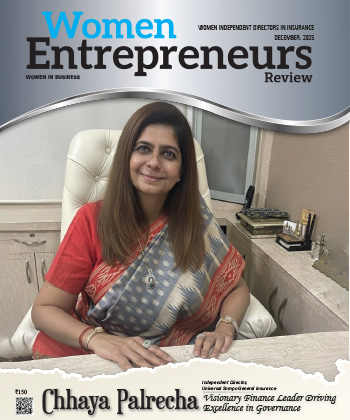
Blueprint for Success: Women Engineers Navigating Professional Path
By: Sangeeta Kaushik, Executive Director, NTPC Limited
Sangeeta Kaushik, Executive Director of NTPC Limited is an electrical engineer with 38 years of experience in engineering, corporate planning, business development, and consultancy. She has been with NTPC for over thirty-eight years. NTPC is India's leading power utility, the company operates in various energy sources, including coal, renewables, nuclear, hydro, coal mining, power trading, consultancy, and international joint ventures.
In a recent conversation with Women Entrepreneurs Review, Sangeeta emphasizes implementing gender diversity in the workplace that drives improved financial and operational performance. She urges encouraging women engineers and leaders in the tech sector to create a talent pipeline.
How can young women engineers position themselves as architects of disruption? What unconventional skills should they cultivate that the industry isn’t prioritizing yet?
Technology is expected to be the biggest growth accelerator of this century, and women aspiring to build a career in technology must develop the ability to reinvent themselves. Continuous upskilling and seizing opportunities are crucial for women in the technology industry. Women should stay updated with the latest developments in artificial intelligence, machine learning, big data, and blockchain. They should invest in courses, and certifications, and challenge themselves to embrace change.
Women often fall into their comfort zone, but they must work towards the success zone. Online upskilling courses are easily accessible, making it easier for women to participate in opportunities. However, they should also develop business acumen and financial acumen, as well as unconventional skills like understanding the cost of innovations, projects, etc, and their return on investment.
What alternative leadership models could young women engineers champion that would both challenge the status quo and drive innovation? How can these new structures cater to the unique strengths women bring to the engineering space?
Research shows that organizations with gender diversity benefit from improved operational and financial performance. Women can strike a balance between technical capabilities and soft skills, such as empathy and cross-team collaboration, leading to better idea generation and execution. Young women engineers should pitch for this role.
In the early years of their career, girls should focus on their careers and work towards success faster. Women should accept that they are natural caregivers therefore as they start their family or become responsible for aging parents, they may need to take a back seat. There is therefore a need to invest in strong support systems at work and home. Women should develop mentors and sponsors, as one person talking about them is less positive in the workspace environment. Networking across departments and organizations is essential for women's growth.
Social media has made networking easier, allowing women to reach out to their networks across departments and organizations. Engaging with friends, attending conferences, and engaging online can provide valuable input for women. Support systems should be effective at home and work, ensuring that women can rely on them during challenges and maintain a strong support system to handle disruptions.
When discussing the leadership model, women should pitch for their value and the soft skills they bring to the table, such as empathy, team collaboration, and multitasking. By doing so, they can contribute to the success of their organization and contribute to the overall success of their team.
How can women engineers lead the charge in addressing algorithmic bias? What ethical responsibilities do they need to push for?
AI development faces bias due to a lack of diversity in design and development. For example, women have been driving cars for ages however designers have never thought of an identified space for women's handbags. Identified space has even been found for placing spectacles in the car but no design to include space for handbags.
Increasing gender diversity in the tech field can lead to more objectivity and reduce bias. Technology can play a crucial role in bringing more female role models to the tech industry, reducing stereotypes, and promoting objectivity in AI development.
How can young female engineers redesign the blueprint of success by utilizing the barriers they encounter to redefine industry practices? Are there specific obstacles that, if reimagined, could fuel innovation?
Technology companies need to rethink their models to encourage women engineers and leaders in the tech sector. Initially, there were few women engineers, but now almost 50% of the class passing out in engineering are women. Organizations must encourage this pipeline by designing policies that encourage women and actively inducting or recruiting women. For example, NTPC recruited a special batch of women engineers for operational shift duty, ensuring that the numbers will enable them to be comfortable in their surroundings during shift duty including night shifts.
Proactive steps must be taken for women to participate in this pipeline, including creating opportunities for training, mentoring, and guidance. Defined special programs can help women reaffirm their confidence and ability to perform better. Regular courses can help women upgrade themselves and understand other women's challenges.
Opportunities may take a back seat for women, but with support from family, bosses, or organizations, it is easier for them to adapt to new roles. Organizations and women can work together to create a talent pipeline that can be utilized to produce more women leaders in the future. By focusing on women's empowerment and providing opportunities, organizations can create a more inclusive and supportive environment for women in the tech sector.
How can women engineers tap into soft power empathy, collaboration, and emotional intelligence to lead projects in ways that transform not just the outcome but the process itself?
Women possess key strengths such as soft power, empathy, collaboration, and emotional intelligence, which enable them to handle cross-functional teams easily. Their instincts and empathy make them natural caregivers, and their ability to listen effectively is crucial for success in cross-functional teams. This skill can be beneficial to the organization as it ensures that all team members contribute to the team's success.
How could young women engineers decentralize innovation by leveraging open-source solutions, community-driven projects, or even entrepreneurial ventures?
In today's world, there are endless opportunities for career advancement, including both employees and entrepreneurs. Women can utilize technology to foster connections and collaboration, transforming their career trajectory.
Large corporations including PSUs like NTPC, ONGC, IOCL, and BHEL, and big private sector companies like GE, Siemens, L&T, and Tata Power offer diverse opportunities in hardcore tech and engineering roles for women.
Small fintech and social media companies also provide opportunities for women to innovate and connect with others. Even if an organization cannot offer these opportunities, women can explore and innovate in these areas by keeping their eyes and ears open. By embracing these opportunities, women can capitalize on their skills and make a positive impact in their careers.
Message to Readers
Women should go out and ask for help instead of trying to become superhumans. I would say that there is no need to become a superwoman. Always ask for help, whether it is at home or office. Never hesitate to ask questions.
Most Viewed
- 1 Women's Health Startup HerMD Closing Doors Amid Industry Challenges
- 2 5 Famous Women in Indian Armed Forces
- 3 Saudi Women No longer Require Male Permission for Clothing Choices, says Prince MbS
- 4 Kolkata Medtech Startup Innovodigm Raises Rs 5.5 Crore Seed Funding Led by IAN Group
- 5 Yamunanagar's Kashish Kalra Honoured after Securing 111th Rank in UPSC Civil Services Exam
- 6 Madurai Appoints Its First Woman Corporation Head
- 7 IAS Vijayalakshmi Bidari Appointed as the new Nagpur Divisional Commissioner
- 8 American Entrepreneur Lucy Guo Overtakes T Swift to become Youngest Female Billionaire
- 9 ICC Women's World Cup 2025 Trophy Showcased at Indore's Holkar Stadium
- 10 Aparna Saxena's Beauty Venture AntiNorm Launches in India
- 11 Vidya Nataraj Co-Founded BlueStone Jewellery & Lifestyle files IPO
- 12 5 Women Freedom Fighters of India
- 13 Dr. G Krishnapriya appointed as CEO for Trichy
- 14 M3M & Sirona Partner to Introduce Menstrual Hygiene Vending Machines in 15 Locations
- 15 Punjab Govt launches SHE Cohort 3.0 Supporting Tech-led Women Startups
- 16 Indian origin Lawyer, Sweena Pannu appointed as the US New Superior Court Judge
- 17 The Aurora Tech Award recognizes 4 Indian Women-led Startups
- 18 Kerala's Republic Day parade featured an all-female tableau
- 19 Manisha Kabbur Becomes Karnataka's First Woman International Karate Coach
- 20 Director K. S. Ravikumar's Daughter Maalica Ravikumar Launches Life Coaching Company 'Evergrowth Academy' for Women
- 21 Leezu's Raises Pre-Seed Funding to Accelerate Growth in Sexual Wellness Industry
- 22 Sattu: Super-easy summer drink for PCOS gut healing
- 23 Swathi Nelabhatla creates Sitha App, India's First Women-Exclusive Gig Platform
- 24 7 Timeless Female Kathak Dancers & their Iconic Legacies
- 25 Meet 7 Iconic Women Architects of Modern India & their Most Impactful Work
- 26 This Woman-led Insuretech Startup is Helping Bridge the Education Financing Gap in India
- 27 Women Leaders Share Lessons Learnt from India Women's WC Win
- 28 5 Enterprising Women Founders Powering Singapore's Tech & Innovation Landscape
- 29 4 Women. 4 Stories. One Vision for Smarter, Stronger Healthcare
- 30 Global Gender Gap Narrows to 68.8%, But Full Equality 123 Years Away: WEF Report 2025
- 31 Changemakers: 7 Women Entrepreneurs Taking the Make in India Movement Forward
- 32 Meet Lucy Guo, The Youngest Self-Made Female Billionaire Disrupting Tech
- 33 How Women are Driving India's Festive Online Shopping Surge






